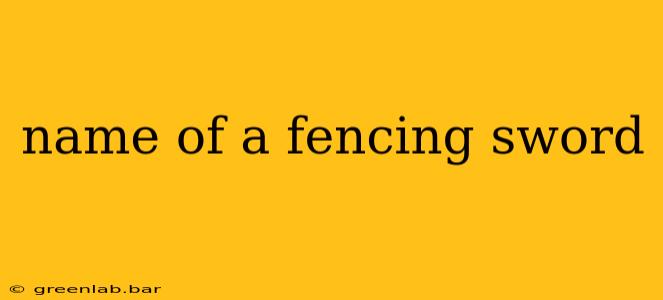Fencing, a sport demanding precision, skill, and strategy, utilizes a variety of swords, each with its unique characteristics and name. Understanding the nomenclature is crucial for both participants and spectators. This guide delves into the names of fencing swords, exploring their historical context and modern usage.
The Three Main Types of Fencing Swords
Modern fencing competitions primarily feature three weapon types:
1. Foil
The foil, a lightweight thrusting weapon, is characterized by its slender blade and button tip. Its historical roots trace back to the 18th century, evolving from earlier dueling swords. In foil fencing, only touches to the torso (from the collarbone to the groin) are valid scoring hits. The right-of-way system, which dictates who scores in the event of a simultaneous touch, is crucial in foil competitions. The foil's relatively light weight demands speed and precision.
2. Épée
The épée, a heavier thrusting weapon, allows touches anywhere on the body. Unlike the foil, the épée lacks a right-of-way system; both fencers score if they hit simultaneously. This difference profoundly affects the strategic approach to the sport. Its heavier weight emphasizes control and timing over sheer speed. The épée's design is more robust and its tip is sharper, though still blunted for safety.
3. Sabre
The sabre, a cutting and thrusting weapon, is the most dynamic of the three. Touches are valid on any part of the body above the waist. Cutting actions, which are not allowed in foil or épée, are a critical component of sabre fencing. Its curved blade and distinct techniques result in a faster-paced and more aggressive style of play. The sabre's weight sits between the foil and épée, demanding a balance of speed and power.
Beyond the Basics: Variations and Historical Context
While foil, épée, and sabre represent the core of modern competitive fencing, understanding the historical context reveals a wider array of sword names. Many historical swords, though not used in modern Olympic fencing, significantly influenced the development of these three weapons. These include, but are not limited to, rapiers, smallswords, and cutlasses, each possessing unique characteristics and wielding methods.
Furthermore, the specific names for components of fencing swords, like the forte (heavier portion near the hilt), foible (lighter portion near the point), and guard, are essential terminology for understanding weapon handling and technique.
Conclusion: Mastering the Language of Fencing
Understanding the names of fencing swords is crucial for anyone seeking a deeper appreciation of this elegant and demanding sport. From the lightweight foil to the powerful épée and dynamic sabre, each weapon brings its own unique set of challenges and strategies, demanding different skill sets and approaches from fencers. Beyond the basic three, exploring the historical context of sword design enhances comprehension of the evolution of this intricate and fascinating martial art.

